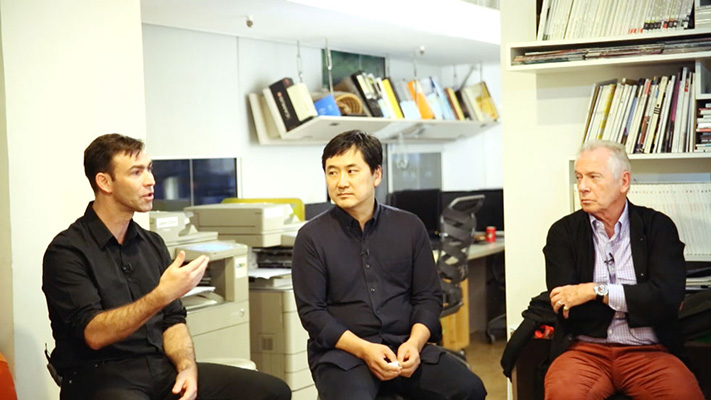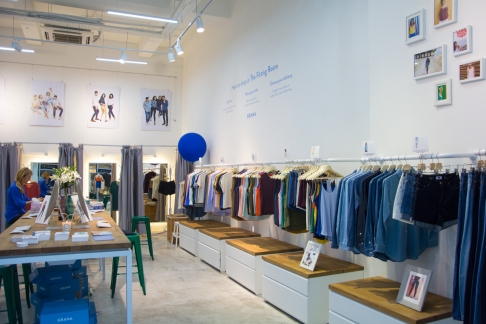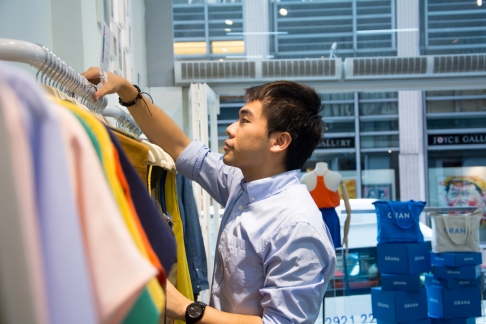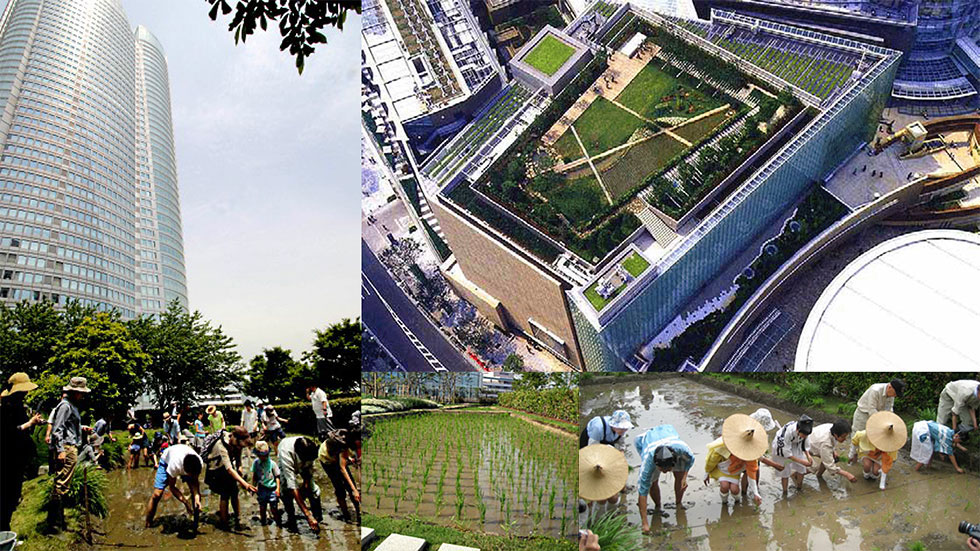Imagining the New Retail Destination
- Creativity/
- Place Branding/
- Retail/
- Social Destinations/
By Claudia Lee & Marc Cansier
Share

From L-R: Jerome De Baecque, Phil Kim and Francis Gouten sharing their thoughts on future shopping experiences in our last Le Salon discussion.
During the past decades, unconventional business models, new trends and the growth of e-commerce have threatened the traditional retail format. Creative agency Marc & Chantal has gathered experienced members from the architectural, luxury retail and digital technology industries to come together and discuss ‘The Future of Retail’. The discussion centres on the significance and ramifications of new trends as well as the possible solutions for developers.
FIGHTING SAMENESS
Authenticity and customization are the keys for the future programming of retail
Drawing insights from his experience designing shopping complexes and social hubs at Jerde Partnership, architect Phil Kim believes “authenticity and customization are important for the future programming of retail”. Kim points out Shibuya 109, a young women oriented 10 level department store in Tokyo, as a successful case study. Shibuya 109’s ability to tap into the modern consumer’s ‘fear of missing out’ is exactly what led to its success, as Kim explains “young women have a desire to explore and return, because those goods are actually gone at the end of 7 days, never to return”.
The previous CEO of Richemont group and a veteran of Asia’s luxury retail industry, Francis Gouten identifies that the next step is to show both developers and competing brands that niche markets are the way forward, “I’m currently advising some shopping malls to curate small, unique brands, to reserve some space in their planning, so as to show something different than the Mall next door. I’m absolutely convinced that this is what the market wants”.

Grana currently has two pop-up stores in Hong Kong and constantly seeks consumer opinions on the next pop-up location.

Net-A-Porter is an online luxury retailer that has shaped its technology around consumer insights. Aware of the importance of physicality to consumers, the firm publishes a monthly magazine and developed an app allowing customers to ‘shop the magazine’. A simple scan enables customers to browse and buy products online, exemplifying how technology can truly make the shopping experience seamless. Innovative ways of integrating retail and technology is also evident in the household goods industry. For instance, Ikea’s augmented reality app allows consumers to photograph their living space and place any piece of Ikea furniture in the space.
This situation is comparable to the checking-in process in hotels, which is now increasingly by-passed by technology via an online check-in. In the hospitality industry, spaces and resources used to maintain processes now driven by technology will instead be used to deliver higher quality experiences and better service. Thanks to technology, similar principles will profoundly transform the retail industry in the next 10 years, enabling retailers to focus human resources on building qualitative experiences.
How an online community can teleport itself into reality
Gouten points out another strong trend “there is a trend in the US and the UK today where E-business companies open shops, because you need to find a place to talk to your clients… and your users”. Amazon’s decision to open its first physical bookstore in 2016 is a reminder of the importance of a human touch in any retail experience. Using physical stores as product pickup stations will ease Amazon’s distribution burden while offering a spot for consumers to try Amazon products such as the ‘kindle’ before purchase [2]. The online juggernaut stepping into the ‘real world’ shows that a human touch is necessary in any retail experience, reinforcing Kim’s opinion that “…online retail can’t really destroy the physical retail world”. Instead, the keyword for both offline and online retailers should be ‘integration’.
Jerome De Baecque, the Director of Creative Studio and Digital Agency Spinifex Group, points out “at the end of the day, it’s about making the experience fun and enjoyable”. Technology will help smooth the bumps in the customer journey, but will never replace a meaningful human interaction.

Inside Amazon’s first physical bookstore in Seattle, customers can find labels displaying reviews and ratings of books made by online users.
PROPERTY DEVELOPERS: THE WAKE UP CALL
Survival kit to the new paradigm
The surge in popularity of pop-up stores reflects the modern consumer’s attraction to exclusivity and surprise. As Jeremy Baras, the CEO of PopUp Republic stated in an interview, “Customers are attracted to a ‘here today, gone tomorrow’ type of concept.” [3] Gouten and Kim have both emphasized the importance of a retail format that facilitates pop-up stores and diversity for the developer to differentiate its offerings from competitors. Kim explains “Adaptability is something the smarter retail operator will take on, shorter term leases, much more flexible spaces”.
When asked to describe an ‘ideal brief’ from a developer, Kim expresses the brief would challenge designers to consider sustainability by asking questions such as: How can the shopping center evolve to also provide services, functions, entertainment and recreational activities? Kim shares that the key is not building an entirely new retail space centered on current trends but to build a sustainable retail hub that satisfies modern consumer desires and social needs. Marc & Chantal’s recent project, UTOPA, is an example of a space that seeks to transcend the conventional mall to become a destination which aligns with people’s pursuit of an ideal life. To achieve this, developers have combined elements of shopping, entertainment, education, medical care and charity into the integrated O2O community.
REDEFINING THE ‘ANCHOR EXPERIENCE’
Creating a popular destination requires not only a positive experience but also an identity that sets it aside from the multitude of destinations with similar offerings. Traditional concepts of ‘an anchor department store’, such as Macy’s in the U.S that serve as the primary purpose of a consumer’s visit seem no longer viable in the face of the desire for experiential retail.
There has been a clear shift in the industry’s focus on ‘anchor experiences’, with developers significantly raising the F&B and entertainment ratios in their retail spaces. Kim uses La Boqueria, a food market in Barcelona’s La Rambla shopping street, as a traditional example of a successful anchor experience. He observes, “the market…anchors an experience that allows people to continue to meander and partake in other things.”
Landowners and developers will have to curate those experiences.

Children, residents and workers in the Roppongi Hills district can experience rice harvest season in the middle of a modern metropolis.
Defining engaging anchor experiences will be the holy grail of retail success in the years to come. As Kim suggests, it could come down to combining two unlikely destinations together to create a refreshing experience. In Tokyo’s Roppongi Hills, a developer introduced an experience of Japanese rural life amongst the district’s skyscrapers via a rooftop paddy that can yield rice harvest. The next step will be to place this experience at the very core of the destination, not its periphery. Whatever the experience, retailers should reinvent and reorganize their assets around socially anchored experiences rooted in authenticity.
In Marc & Chantal’s work on Tai Kwun, previously the Central Police Station, the firm has used the site’s unique positioning as a convergence of Hong Kong’s past and present to articulate such anchor. After defining Art and Heritage as the pillars of the experience, the firm wrote guidelines for the selection of tenants to ensure that all commercial activities resonate with the the brand’s core purpose. To reinforce the experience, the firm also built a site-wide heritage museum which encourages visitors to better understand its history.
The strategies highlighted by the speakers require enhanced collaboration by retail stakeholders, namely landowners, developers and individual tenants. Marc & Chantal’s co-founder Marc Brulhart concludes, “landowners and developers will have to curate those experiences as well as invest in the proper staff training in order to deliver this new experience. It is important that all parties take on a new role and face the obstacles with an entrepreneurial mindset.” •
1 GRANA Raising US$10 Million with Alibaba Entrepreneurs Fund
http://www.dailymail.co.uk/wires/reuters/article-3820780/GRANA-Raising-US-10-Million-Alibaba-Entrepreneurs-Fund.html
2 This Is Why Amazon Will Open Physical Bookstores
http://www.computerworld.com/article/3030321/e-commerce/this-is-why-amazon-will-open-physical-bookstores.html
3 Pop-Up Stores Become More Than Just A Trend
http://www.retailtouchpoints.com/features/special-reports/pop-up-stores-become-more-than-just-a-trend
